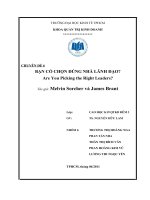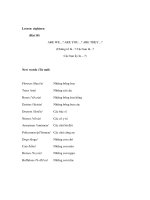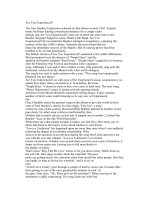Computer are you future
Bạn đang xem bản rút gọn của tài liệu. Xem và tải ngay bản đầy đủ của tài liệu tại đây (1.22 MB, 37 trang )
Computers Are
Your Future
© 2005 Prentice Hall, Inc.
© 2005 Prentice Hall, Inc. Slide 2
Computers Are Your Future: Chapter 12
Computers Are Your Future
Chapter 12
Programming Languages and
Program Development
© 2005 Prentice Hall, Inc. Slide 3
Computers Are Your Future: Chapter 12
What You Will Learn About
What a programming language is
Machine language and assembly language
High-level programming languages
The shortcomings of early languages
Popular programming languages
© 2005 Prentice Hall, Inc. Slide 4
Computers Are Your Future: Chapter 12
What You Will Learn About
The six phases of the program development life cycle
(PDLC)
Why top-down programming makes programs easier
to debug and maintain
The three basic types of control structures
Syntax errors and logic errors in programs
© 2005 Prentice Hall, Inc. Slide 5
Computers Are Your Future: Chapter 12
Machine Language
Ada
Pascal
Fortran
COBOL
Assembly Language
Smalltalk
Visual Basic
BASIC
JavaC and C++
Programming Languages
Programming languages are artificial languages
created to tell the computer what to do
They consist of vocabulary and a set of rules to
write programs
The program development life cycle (PDLC) is
an organized method of software development
© 2005 Prentice Hall, Inc. Slide 6
Computers Are Your Future: Chapter 12
Development of Programming Languages
Programming languages are classified by levels or
generations
Lower-level languages are the oldest
The five generations of programming languages are:
Machine languages
Assembly languages
Procedural languages
Problem-oriented languages
Natural languages
© 2005 Prentice Hall, Inc. Slide 7
Computers Are Your Future: Chapter 12
First-Generation Languages
Machine language:
Consists of binary numbers (0s
and 1s)
Is the earliest programming
language
Is the only language the
computer understands without
translation
Is machine dependent
Each family of processors has
its own machine language
© 2005 Prentice Hall, Inc. Slide 8
Computers Are Your Future: Chapter 12
Second-Generation Languages
Assembly language:
Resembles machine language
Is a low-level language
Uses brief abbreviations for
program instructions.
Abbreviations are called
mnemonics
A program is written in source
code (text file) and translated
into machine language by an
assembler
© 2005 Prentice Hall, Inc. Slide 9
Computers Are Your Future: Chapter 12
Third-Generation Languages
Procedural languages:
Are high-level languages that tell the computer what to
do and how to do it
Create programs at a high level of abstraction
Are easier to read, write, and maintain than machine
and assembly languages
Use a compiler or interpreter to translate code
Fortran and COBOL are third-generation
languages
© 2005 Prentice Hall, Inc. Slide 11
Computers Are Your Future: Chapter 12
Third-Generation Languages (continued)
Spaghetti Code and the Great Software Crisis:
GOTO statements resulted in programs that were
difficult to follow
This problem led to the software crisis of the 1960s
Programs were not ready on time
Programs exceeded their budgets
Programs contained too many errors
Customers were not satisfied
© 2005 Prentice Hall, Inc. Slide 12
Computers Are Your Future: Chapter 12
Third-Generation Languages (continued)
Structured programming languages:
Were developed to improve software development
Include Algol and Pascal
Forbid the use of GOTO statements
Use control structures
IF-THEN-ELSE
© 2005 Prentice Hall, Inc. Slide 13
Computers Are Your Future: Chapter 12
Third-Generation Languages (continued)
Modular programming languages:
Were developed because of problems in structured
programming languages
Are used to create programs that are divided into
separate modules
Each module carries out a special function
Require specified input to produce specified output
© 2005 Prentice Hall, Inc. Slide 14
Computers Are Your Future: Chapter 12
Fourth-Generation Languages
Types of fourth-generation languages include:
Report generators
Languages for printing database reports
Query languages
Languages for getting information out of databases
Fourth-generation languages are nonprocedural
They do not force programmers to follow procedures to
produce results
© 2005 Prentice Hall, Inc. Slide 15
Computers Are Your Future: Chapter 12
Object-Oriented Programming
Object-oriented programming (OOP):
Relies on component reusability
The ability to produce program modules that perform a
specific task.
Eliminates the distinction between programs and data
Uses objects that contain data and procedures
© 2005 Prentice Hall, Inc. Slide 16
Computers Are Your Future: Chapter 12
Objects
Objects are units of information
that contain data as well as
methods that process and
manipulate the data
Classes of objects:
Hierarchy or category of objects
Objects at the top of the
category are broader in scope
than the subclass objects
Inheritance refers to an object’s
capacity to “pass on” its
characteristics to its subclasses
© 2005 Prentice Hall, Inc. Slide 17
Computers Are Your Future: Chapter 12
Sample Cobol program
Common Business-Oriented Language (COBOL)
COBOL:
The earliest (1959)
high-level language
The most widely used
business language
A proven way to do
accounting, inventory,
billing, and payroll
Requires programmers
to explain what the
program is doing at
each step
© 2005 Prentice Hall, Inc. Slide 18
Computers Are Your Future: Chapter 12
Sample Fortran program
Formula Translator (Fortran)
Fortran:
Began in the 1950s
Is suited to scientific,
mathematical, and
engineering applications
Is used to solve
complex equations
Features simplicity,
economy, and ease of
use
© 2005 Prentice Hall, Inc. Slide 19
Computers Are Your Future: Chapter 12
Sample Ada program
Ada
Ada:
Named after Augusta
Ada Byron
Incorporates modular
programming
The required language
for the U.S. Defense
Department
Suitable for control of
real-time systems
(missiles)
© 2005 Prentice Hall, Inc. Slide 20
Computers Are Your Future: Chapter 12
Sample BASIC program
Beginner’s All-Purpose Symbolic
Instruction Code (BASIC)
BASIC:
An easy-to-use language available on personal computers
Widely taught in schools as a beginner’s programming
language
Designed as an interpreted language
© 2005 Prentice Hall, Inc. Slide 21
Computers Are Your Future: Chapter 12
Visual Basic (VB)
Visual Basic:
Is widely used in program
development packages
Uses event-driven
programming
Enables the programmer to
develop an application by
using on-screen graphical user
interfaces
Sample Visual Basic
© 2005 Prentice Hall, Inc. Slide 22
Computers Are Your Future: Chapter 12
Sample Pascal program
Pascal
Pascal:
Is named after Blaise Pascal
Encourages programmers to write well-structured programs
Widely accepted as a teaching language
Has been updated to reflect new approaches to programming
© 2005 Prentice Hall, Inc. Slide 23
Computers Are Your Future: Chapter 12
Sample C program
C
C:
Was developed by
AT&T’s Bell Labs
in the 1970s
Combines high-
level programming
language with
assembly language
Programmers
manipulate bits of
data within a
processing unit
Difficult to learn and
programming is time
consuming
© 2005 Prentice Hall, Inc. Slide 24
Computers Are Your Future: Chapter 12
Sample Smalltalk program
Smalltalk
Smalltalk:
Developed in the 1970s by
Xerox Corp
“100% pure” object-oriented
programming language
Not often chosen for software
development
© 2005 Prentice Hall, Inc. Slide 25
Computers Are Your Future: Chapter 12
C++
C++:
Incorporates object-
oriented features
Is widely used for
professional program
development
Sample C++ program
© 2005 Prentice Hall, Inc. Slide 26
Computers Are Your Future: Chapter 12
Java
Java:
Developed by Sun Microsystems
An object-oriented, high-level programming language with
a twist
First true cross-platform programming language
Gained acceptance faster than any other programming
language
A simplified version of C++









